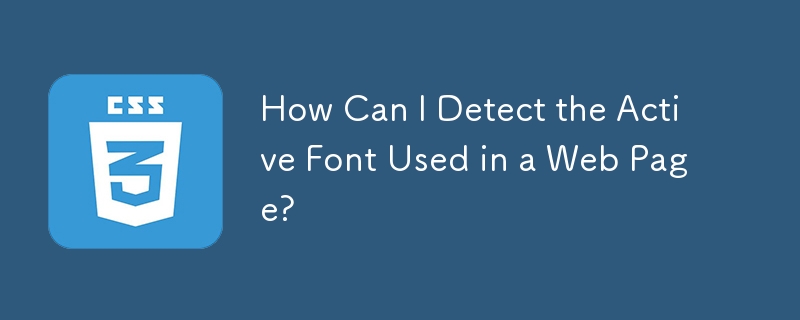How Can I Detect the Active Font Used in a Web Page?

Detecting the Active Font in a Web Page
When designing web pages with diverse fonts, it becomes crucial to ensure that the desired font is rendered on the user's browser. This can be a challenge when multiple fonts are defined in the CSS.
One approach to addressing this issue is to determine which of the specified fonts is actually being used. By identifying the active font, you can take appropriate actions, such as displaying a download link for fonts that are not installed on the user's system.
Font Detection Technique
A common technique used for font detection involves measuring the width of rendered text using a specific font. If the measured width matches the expected width for the desired font, it indicates that the target font is present on the user's device. However, this method is less reliable for monospaced fonts.
Example Implementation
The following code snippet illustrates how this technique can be implemented:
<div>
// Get the element's width with the desired font
var desiredWidth = document.getElementById("font-detector").offsetWidth;
// Set the element to use a fallback font
document.getElementById("font-detector").style.fontFamily = "monospace";
// Measure the width again using the fallback font
var fallbackWidth = document.getElementById("font-detector").offsetWidth;
// Check if the desired font is installed
if (desiredWidth === fallbackWidth) {
// The desired font is not installed
} else {
// The desired font is installed
}Benefits and Limitations
This font detection technique is relatively simple to implement and can be used to dynamically adjust the page's behavior based on the availability of specific fonts. However, it may not be foolproof and can be influenced by factors such as browser settings or user-installed extensions that modify font rendering.
The above is the detailed content of How Can I Detect the Active Font Used in a Web Page?. For more information, please follow other related articles on the PHP Chinese website!

Hot AI Tools

Undresser.AI Undress
AI-powered app for creating realistic nude photos

AI Clothes Remover
Online AI tool for removing clothes from photos.

Undress AI Tool
Undress images for free

Clothoff.io
AI clothes remover

Video Face Swap
Swap faces in any video effortlessly with our completely free AI face swap tool!

Hot Article

Hot Tools

Notepad++7.3.1
Easy-to-use and free code editor

SublimeText3 Chinese version
Chinese version, very easy to use

Zend Studio 13.0.1
Powerful PHP integrated development environment

Dreamweaver CS6
Visual web development tools

SublimeText3 Mac version
God-level code editing software (SublimeText3)

Hot Topics
 1664
1664
 14
14
 1423
1423
 52
52
 1317
1317
 25
25
 1268
1268
 29
29
 1244
1244
 24
24
 How to Create an Animated Countdown Timer With HTML, CSS and JavaScript
Apr 11, 2025 am 11:29 AM
How to Create an Animated Countdown Timer With HTML, CSS and JavaScript
Apr 11, 2025 am 11:29 AM
Have you ever needed a countdown timer on a project? For something like that, it might be natural to reach for a plugin, but it’s actually a lot more
 HTML Data Attributes Guide
Apr 11, 2025 am 11:50 AM
HTML Data Attributes Guide
Apr 11, 2025 am 11:50 AM
Everything you ever wanted to know about data attributes in HTML, CSS, and JavaScript.
 A Proof of Concept for Making Sass Faster
Apr 16, 2025 am 10:38 AM
A Proof of Concept for Making Sass Faster
Apr 16, 2025 am 10:38 AM
At the start of a new project, Sass compilation happens in the blink of an eye. This feels great, especially when it’s paired with Browsersync, which reloads
 How to Build Vue Components in a WordPress Theme
Apr 11, 2025 am 11:03 AM
How to Build Vue Components in a WordPress Theme
Apr 11, 2025 am 11:03 AM
The inline-template directive allows us to build rich Vue components as a progressive enhancement over existing WordPress markup.
 While You Weren't Looking, CSS Gradients Got Better
Apr 11, 2025 am 09:16 AM
While You Weren't Looking, CSS Gradients Got Better
Apr 11, 2025 am 09:16 AM
One thing that caught my eye on the list of features for Lea Verou's conic-gradient() polyfill was the last item:
 A Comparison of Static Form Providers
Apr 16, 2025 am 11:20 AM
A Comparison of Static Form Providers
Apr 16, 2025 am 11:20 AM
Let’s attempt to coin a term here: "Static Form Provider." You bring your HTML
 PHP is A-OK for Templating
Apr 11, 2025 am 11:04 AM
PHP is A-OK for Templating
Apr 11, 2025 am 11:04 AM
PHP templating often gets a bad rap for facilitating subpar code — but that doesn't have to be the case. Let’s look at how PHP projects can enforce a basic
 The Three Types of Code
Apr 11, 2025 pm 12:02 PM
The Three Types of Code
Apr 11, 2025 pm 12:02 PM
Every time I start a new project, I organize the code I’m looking at into three types, or categories if you like. And I think these types can be applied to




